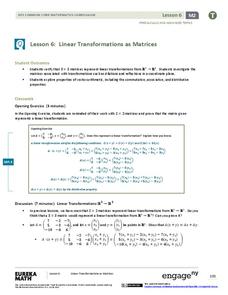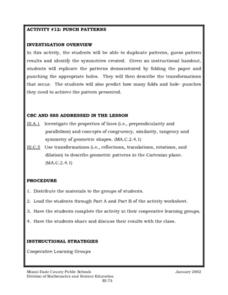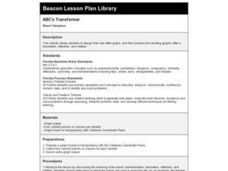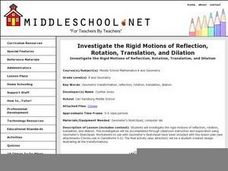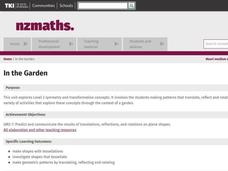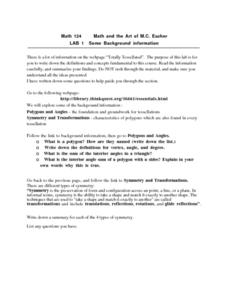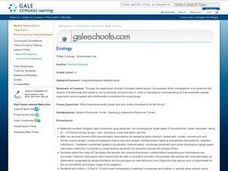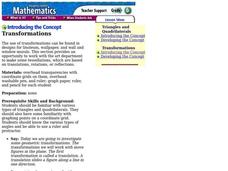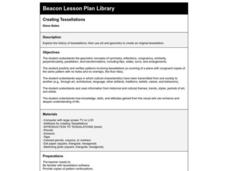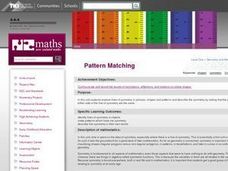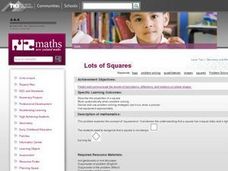EngageNY
Why Move Things Around?
Explore rigid motion transformations using transparency paper. Learners examine a series of figures and describe the transformations used to create the series. They then use transparency paper to verify their conclusions.
Curated OER
Dihedral Figures
Middle and high schoolers perform transformations. For this web based lesson, students explore dihedral figures. They use the web tools to translate, rotate, and reflect figures. Pupils identify lines of symmetry.
Illustrative Mathematics
Lines of Symmetry for Quadrilaterals
Explore how lines of symmetry help define different categories of quadrilaterals. Looking at a square, rectangle, trapezoid, and parallelogram, young mathematicians discover that each shape has its own, unique symmetry. Encourage your...
Charleston School District
Identifying Series and Determining Congruence or Similarity
Learners consider a set of questions to determine a series of transformations that will move one figure to another. Once the series is determined, the pupil then determines whether the pre-image and image are either congruent or similar.
EngageNY
Are All Parabolas Congruent?
Augment a unit on parabolas with an instructive math activity. Pupils graph parabolas by examining the relationship between the focus and directrix.
EngageNY
Linear Transformations as Matrices
Don't stop with two-dimensional learning, go to the next dimension! Learners verify that 3x3 matrices represent linear transformations in the third dimension. Additionally, they verify the algebraic properties that extend to vector...
Curated OER
Shapes in Motion
Students practice moving different shaped objects through a series of transformations. In groups, they discuss other ways to manipulate the figure to achieve the same results. They solve multiple story problems in the same manner.
Curated OER
Punch Patterns
Fifth graders duplicate patterns, guess pattern results and identify the symmetries created. They are given an instructional handout, 5th graders replicate the patterns demonstrated by folding the paper and punching the appropriate...
Curated OER
Stereoisomers
Students investigate stereoisomers using models that can be rotated and manipulated. In this stereoisomers lesson plan, students try to make models of molecules look alike by rotating the bonds. Using a mirror, the teacher demonstrates...
Curated OER
ABC's Transformer
Fourth graders design their own letter graph, and then produce the resulting graphs after a translation, reflection, and rotation. After a review of vocabulary, 4th graders create their graphs using crayons.
Curated OER
Lines of Symmetry
Fourth graders demonstrate lines of symmetry using polygons, pentominoes, and block letters of the alphabet. They describe, identify, and analyze characteristics and properties of geometric shapes.
Curated OER
Investigate the Rigid Motions of Reflection, Rotation, Translation, and Dilation
Students investigate the rigid motions of reflection, rotation, translation, and dilation. This investigation be accomplished through classroom instruction and exploration using Geometer's Sketchpad.
Curated OER
In The Garden
Students examine symmetry and transformation concepts. They create patterns that translate, reflect and rotate. Students participate in a variety of activities that explore transformation concepts through the context of a garden.
Curated OER
Math Lab
In this polygons and angles worksheet, 10th graders complete 5 different questions related to polygons and angles, in addition to symmetry and transformations. First, they define polygon and how they are named. Then, students define...
Curated OER
Ecology - Biodiversity Lab
Studnents examine the degree of biodiversity that exists in one's everyday environment, in order to develop an understanding of how scientists classify organisms and to explain why biodiversity is important for living things.
Curated OER
Transformations
Young scholars draw on graph paper. In this geometry lesson plan, students review types of triangles and quadrilaterals. Young scholars investigate geometric transformations, including translation, rotation and reflection. Students...
Curated OER
Creating Tessellations
Third graders explore the history of tessellations; then use art and geometry to create an original tessellation.
Curated OER
Fold and Cut
Second graders explore line symmetry and the names and attributes of two-dimensional mathematical shapes. They study the context by folding and cutting out shapes to make a series of mathematical shapes.
Curated OER
Pattern Matching
First graders examine how to determine the lines of symmetry in pictures, shapes, and patterns by completing the lessons in this unit. They make patterns that show a line of symmetry and describe it using their own language.
Curated OER
Strawberry and Chocolate Milk
Students listen to the math problem and discuss. They work alone or in groups to come up with the possible solutions and put their pictures of the bottle arrangements on the wall so that the class can refer to them.
Curated OER
Rotations
Young scholars discuss the concepts of reflection, rotation, and translation. In this rotation activity, students investigate rotations through examples on an overhead projector. No additional worksheet or student assignment is included.
Curated OER
Cracks on the Walls
Young scholars observe the cracks in school walls and pavements. For this geometry lesson, students explore the factors to be considered before building a structure. They complete a graphing and calculation worksheet after the lesson.
Curated OER
Strawberry Milk
Students work in groups or alone to solve the problem. They use a systematic approach to get all possible answers. They report back to the class with solutions. They may extend their studying using a crate with room for 9 bottles.
Curated OER
Lots of Squares
Learners work in pairs, to make a square on the geoboards with a rubber band (or draw one on the dot paper). It can be any size and in any location and share their answers with the class.







